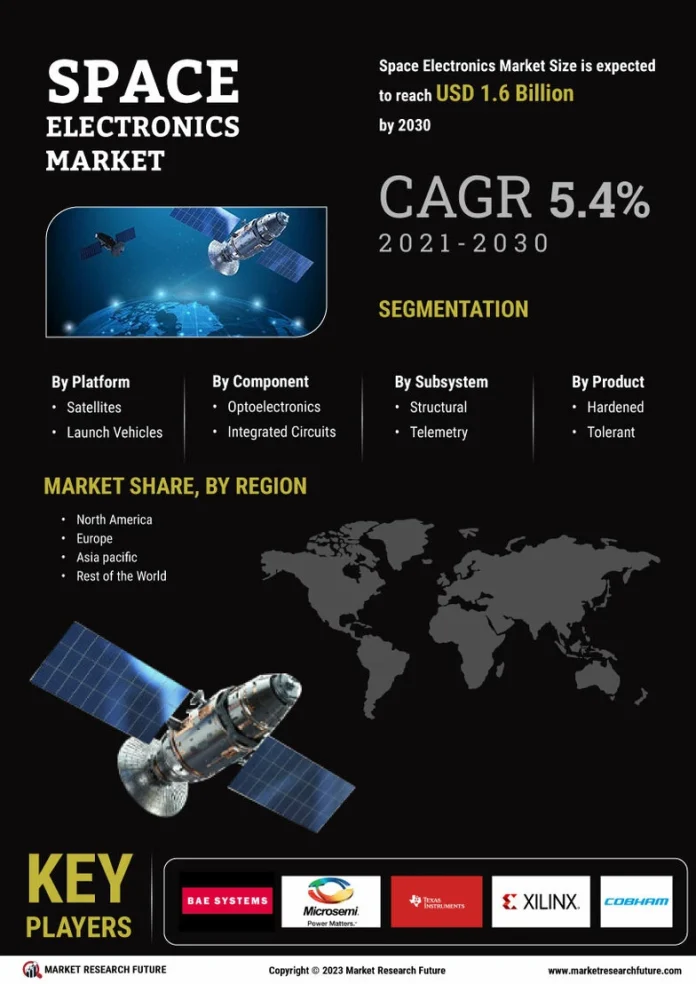Space Electronics Market Forecast
The space electronics market is poised to experience significant growth, registering a compound annual growth rate (CAGR) of 5.4% during the forecast period and is projected to reach USD 1.6 billion by 2030. This market encompasses the manufacturing and development of electronic components and systems designed for space exploration and satellite applications. It includes a wide range of devices such as sensors, communication systems, power systems, control systems, and computing systems utilized in spacecraft, satellites, and other space missions. Space electronics are engineered to withstand harsh environments characterized by extreme temperatures, radiation, vacuum conditions, and high vibration levels.
Receive a complimentary sample report to preview the valuable insights and data we offer on the space electronics market.
Segment Analysis
The global space electronics market is segmented based on product and application.
- Sensors Segment: In 2022, the sensors segment accounted for over 40% of the global space electronics market share. Sensors measure various parameters in space, such as temperature, pressure, and radiation. They are integral to applications like navigation, communication, and Earth observation.
- Actuators Segment: The actuators segment is the fastest-growing segment, holding over 30% of the market share in 2022. Actuators are essential for controlling mechanisms and systems in space vehicles.
- Satellite Segment: Dominating the market, the satellite segment is expected to grow at a CAGR of 5.4% during the forecast period. This growth is driven by the increasing adoption of satellites for modern communication technologies and the development of miniature hardware systems. Investments by governments and private companies in satellite manufacturing, launch services, and space exploration significantly contribute to this segment’s expansion.
Regional Analysis
The global space electronics market is divided into North America, Europe, Asia-Pacific, and the Rest of the World.
- North America: Traditionally a dominant player, North America leads the space electronics market, primarily driven by the United States. NASA (National Aeronautics and Space Administration) and private companies like SpaceX fuel significant demand. Major aerospace and defense companies such as Boeing, Lockheed Martin, and Northrop Grumman also contribute substantially. Canada, through the Canadian Space Agency (CSA), plays a significant role in space electronics development. North America remains a key hub for innovation and production in space electronics.
- Europe: The European space electronics market benefits from the European Space Agency (ESA), which coordinates space activities among its member states. Major European aerospace companies, including Airbus and Thales Alenia Space, hold significant market shares. Countries such as France, Germany, Italy, and the United Kingdom contribute notably to the sector.
- Asia-Pacific: Rapidly expanding its space activities, the Asia-Pacific region is becoming a significant player in the space electronics market. China, with its space agency (CNSA) and companies like China Aerospace Science and Technology Corporation (CASC) and China Great Wall Industry Corporation (CGWIC), drives substantial growth. India, through the Indian Space Research Organisation (ISRO), has also made significant advances. Other countries like Japan and South Korea actively participate in space programs, further contributing to the market.
Key Players
Market Research Future (MRFR) identifies the following companies as key players in the global space electronics market companies
- RUAG Group
- TT Electronics
- BAE Systems
- Cobham Limited
- Texas Instruments Incorporated
- STMicroelectronics
- Xilinx, Inc.
- Microchip Technology Inc.
- Honeywell International Inc.
- Teledyne Technologies Incorporated
These companies play a pivotal role in the development and production of space electronics, driving innovation and growth within the industry.
Conclusion
The space electronics market is on a trajectory of robust growth, driven by advancements in technology and increased investments in space exploration and satellite applications. With a projected CAGR of 5.4%, the market is set to reach USD 1.6 billion by 2030. Key players across various regions continue to innovate, ensuring that the sector remains dynamic and forward-looking. As space missions become more ambitious, the demand for reliable and advanced electronic systems will only increase, cementing the importance of the space electronics market in the broader aerospace industry.
About US
Market Research Future (MRFR) is a global market research company that takes pride in its services, offering a complete and accurate analysis with regard to diverse markets and consumers worldwide. Market Research Future has the distinguished objective of providing the optimal quality research and granular research to clients. Our market research studies by products, services, technologies, applications, end users, and market players for global, regional, and country level market segments, enable our clients to see more, know more, and do more, which help answer your most important questions.
Contact us:
Market Research Future (part of Wantstats Research and Media Private Limited),
99 Hudson Street,5Th Floor New York 10013, United States of America
Sales: +1 628 258 0071 (US) +44 2035 002 764 (UK)
